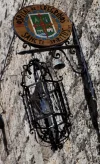I took a photo of the Hospital de Peregrinos Santo Espíritu in Hornillos del Camino. I googled for some information and found this:
"... para romeros y peregrinos." My small Spanish-English dictionary translates 'romero' as 'pilgrim'. 'peregrino' is also translated as 'pilgrim'. So the Hospital was created for pilgrims and pilgrims. An automatic translation gave me 'created for rosemary and pilgrims', which seemed an unlikely alternative.
My question is, therefore, what's the difference between a romero and a peregrino?
Hospital de Peregrinos Santo Espíritu
"Durante la época medieval fueron creados aquí tres hospitales para atender a los peregrinos. Dos de estos lugares llevaban el nombre de San Lázaro, destinado a leprosos y peregrinos, y el Hospital de Peregrinos Santo Espíritu en Hornillos del Camino, es el único que se ha mantenido, creado para romeros y peregrinos. Actualmente este recinto tiene un área separada como lugar de encuentro de la peregrinación moderna." [/viajecaminodesantiago.com/camino-frances/hornillos-camino/]"... para romeros y peregrinos." My small Spanish-English dictionary translates 'romero' as 'pilgrim'. 'peregrino' is also translated as 'pilgrim'. So the Hospital was created for pilgrims and pilgrims. An automatic translation gave me 'created for rosemary and pilgrims', which seemed an unlikely alternative.
My question is, therefore, what's the difference between a romero and a peregrino?
























